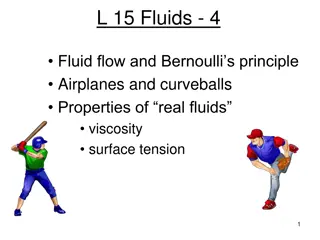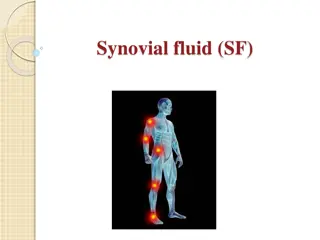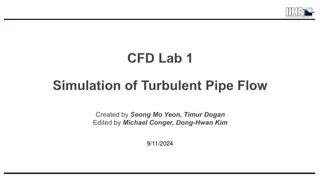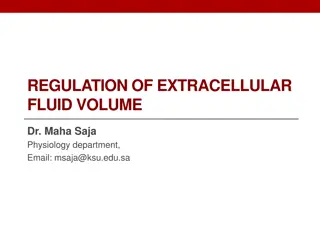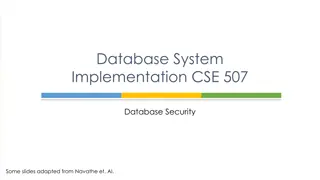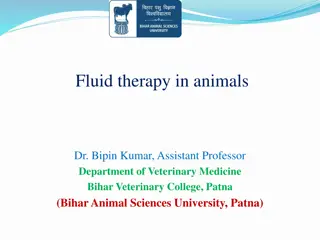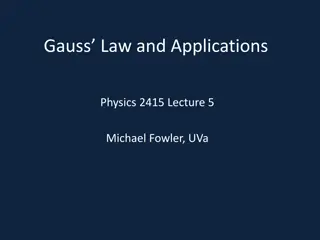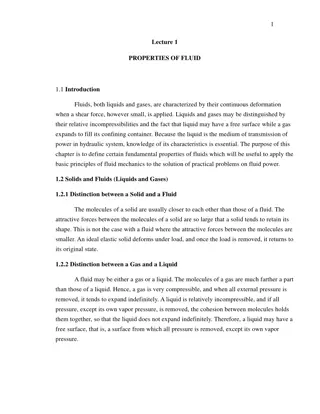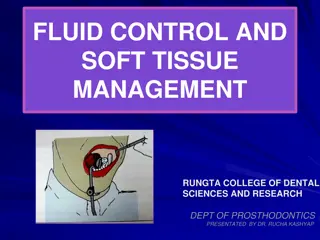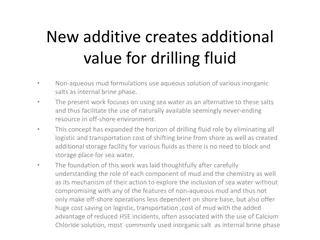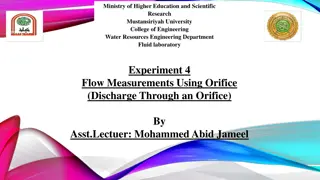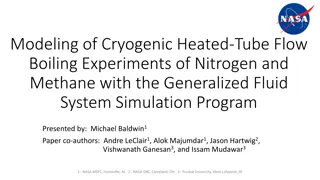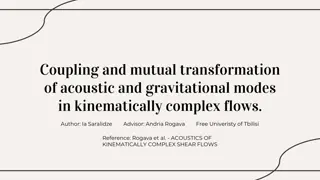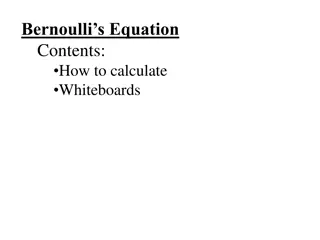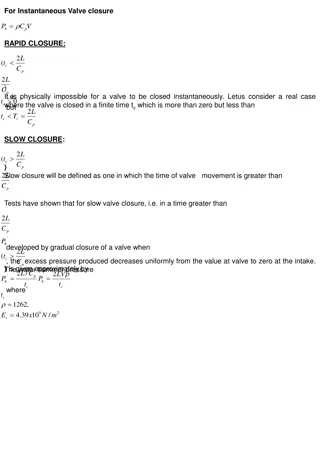Basics of Final Control Elements in Fluid Flow Systems
Final control elements play a crucial role in regulating flow rates within fluid flow processes. Valves, controlled-volume pumps, and variable-speed pump drives are key components. Valves consist of various parts like the body, plug, guides, and seats. Different types of valves, such as single-ported, double-ported, and split-body valves, serve specific purposes based on flow requirements and operational sensitivity.
Download Presentation

Please find below an Image/Link to download the presentation.
The content on the website is provided AS IS for your information and personal use only. It may not be sold, licensed, or shared on other websites without obtaining consent from the author. Download presentation by click this link. If you encounter any issues during the download, it is possible that the publisher has removed the file from their server.
E N D
Presentation Transcript
Petroleum Instrumentation NGT 160 Basics Instrumentation Chapter 3 Final Control Elements This product was funded by a grant awarded by the U.S. Department of Labor s Employment and Training Administration. The product was created by the grantee and does not necessarily reflect the official position of the U.S. Department of Labor. The Department of Labor makes no guarantees, warranties, or assurances of any kind, express or implied, with respect to such information, including any information on linked sites and including, but not limited to, accuracy of the information or its completeness, timeliness, usefulness, adequacy, continued availability, or ownership. Creative Commons License Unless otherwise specified, this work by ShaleNET U.S. is licensed under a Creative Commons Attribution 4.0 International License.
Final Control Elements - overview In a fluid flow process the final element regulates the rate of flow. Most final control elements are valves. But also included are controlled-volume pumps and variable-speed pump drives. A valve used as a final control element consists of a valve, an actuator and piping. The actuator provides the force to operate the valve to control the rate of flow. Actuators can be mechanical, pneumatic, electrical and hydraulic. (discussed later)
Valves Valve parts include the body, the plug, the guides and the seats.
Valves single ported Valve bodies are generally of a round shape and are called globe valves. Single ported valves have a single path for passage of fluid. Valve bonnets are secured to the body in two ways studs and nuts or a clamp ring. (fig 3.2) Valve plugs can be reversed that is push to open or push to close. (seats must be reversed also) These valves cost less, are easier to maintain, more resistant to leakage when closed. However they have trouble dealing with high pressure fluids valves can be difficult to open.
Valves double ported Widely used in automatic control applications. Requires less force than single ported to position its plugs between fully open or fully closed. Used when valve needs to be sensitive to small pressure changes.
Split-body Valves Designed for straight through or right angle flow. Easy to service. Sediment cannot readily buildup inside them.
Angle-body Valves Used when lines need regular draining. Tend to slam shut as the plug nears the seat.
Three-Way Valves They are constant flow devices. That is the position of the plug does not affect the flow through the valve. Single port used for mixing service. Double port used for proportioning service.
Butterfly Valves Cylindrical profile. Straight through flow when wide open. Less expensive to build. Control function limited. Tend to leak through when closed. Requires considerable force to open at high pressures.
Gate Valves Used for isolation. Not good for process control. Has full flow diameter to allow pigging.
Ball Valves Used for isolation.
Check Valves Prevent back flow Example pump discharge or prevent process flow reversal.
Valve Characteristics Flow characteristics the amount of flow through the valve and the extent to which the valve is open. (p. 32-33)
Valve Characteristics Flow capacity maximum volume that can go through a wide-open valve over a unit of time. (p. 33-34) Factors involved: 1. Pressure drop across the valve. 2. Energy difference between the inlet and outlet 3. Viscosity, density, and type of fluid. Other considerations: 1. Ease and smoothness of operation 2. Leakage characteristics 3. Ease of maintenance 4. Self-cleaning features
Valve Plugs (p. 34) Flow characteristics depend on the shape and performance of valve plugs or inner valves. A. Quick Opening provide full flow with comparatively small stem movement. (internal combustion engine) B. V-Port has a linear characteristic for all high values of lift and flow. C. Throttling throttle fluids. Superior for handling slurries and other fluids containing solids.
Valve Plugs (p. 35) Equal percentage if the pressure drop is constant across the valve, they produce equal percentage changes in flow for equal changes in stem lift (opening) Linear flow characteristic is a straight line from zero to maximum flow and lift (opening)
Valve Plugs (p. 36) Low Flow designed to control low flow rates. Flow characteristics can be tailored to fit any pattern desired. Guide stems are larger than the controlling part of the plug.
Other Valve Parts (p. 36-38) Guides insure proper mating of valve plug and seat. Top and bottom stem guides provide excellent stabilization of the plug. Seat Rings often made of metal. Thus metal to metal contact and wear. If long term positive shut off is required seats made of resilient compounds are used. Single seated valves give better shut off than double seated. However single seated are difficult to control near the closure point. Thus when throttling is required double ported is favored.
Other Valve Parts (p. 36-38) Valve Trim the kind of material to make the internal valve parts. Type of trim depends on pressure drop across the valve and the corrosive and erosive qualities of the fluid. Stainless steel is the most popular trim material. It is tough, durable and resists corrosion. Bronze is used for its low cost and when service requirements are mild.
Other Valve Parts (p. 36-38) Valve stems - transmit motion from the actuator to the plug through a seal to withstand line operating pressure. Seals - are usually called stuffing boxes or packing. Good seals - must not only be leak resistant , but also not create too much friction. (See figure 3.1 on slide 20) Seals consist of several rings of composite material made of asbestos and graphite with a system to lubricate the stem. (Also a composite of mica and artificial rubber is used). Teflon a special plastic is popular as packing material. It is resistive to most chemicals, has a wide temperature range, and is self-lubricating. However, Teflon requires special maintenance and specific manufacturer procedures must be followed.
Other Valve Parts (p. 36-38) Bonnet provides a mounting support between the main body and the actuator mechanism and contains the stuffing box. Mounted by threaded joints, studs and nuts, or clamping flanges with a clamp ring. (fig. 3.2, p. 30) Some bonnets have radiating fins to carry away heat of the process fluid. End connections valves are usually connected to piping and equipment by mating flanges (bolted), threaded fittings (lab pneumatic valve), or welding. Welded ends are used in processes that handle dangerous or valuable products where leakage cannot be tolerated, where installation is permanent, maximum pressures are experienced. Welds are inexpensive.
Actuators (p. 39-48) Actuator or operator positions the valve stem to control flow through the valve. Actuators can be mechanical, pneumatic, electric, hydraulic or a combination (eg. electric signal controls a hydraulic system) Mechanical uses bolts, screws, and rods to transmit motion between a sensing device and the final control element.
Actuators (p. 39-48) Pneumatic A diaphragm actuator usually contains a spring that opposes the air pressure applied against a diaphragm. Springless types are controlled by air pressure applied to either side of the diaphragm. A piston actuator is usually springless. A valve positioner fits on the valve actuator and assures that the valve stem movement follows the demands of the controller. It amplifies the force between the controller and the actuator
Actuators (p. 39-48) Pneumatic continued
Actuators (p. 39-48) Pneumatic continued Air supply should be free from moisture, oil and contaminants. A filter collects oil and contaminants. A sump collects condensed moisture that can be drained. I/P converter
Actuators (p. 39-48) Electric Solenoid operated - widely used for two position or on-off flow control. They are reliable and inexpensive. They cannot operate large valves.
Actuators (p. 39-48) Electric Motor operated excellent for open and close operation and remote operation. Reduction gears decrease speed so response time can be slow. Motors are reversible by various means of controls (fig 3.23,24, & 25)
Actuators (p. 39-48) Hydraulic - not as frequently used One advantage hydraulic fluids are virtually incompressible, thus they transmit pressure changes immediately. Commonly used for speed control on steam turbines.
Controlled-volume pumps and variable speed drives A controlled-volume pump delivers a definite and predetermined volume of liquid with each stroke or cycle. A variable speed drive varies the speed of a pump. In large volume systems the final control element often include a variable speed drives which power variable volume pumps. A signal from an electronic control, PLC or similar electrical device operates the pumps. The magnitude of the signal determines the speed of the variable-speed drive, which in turn controls the volume rate of the pump.
Controlled-volume pumps and variable speed drives Are used as injectors for forcing emulsion breakers, inhibitors and chemicals into process lines, tanks and other vessels. Also used to inject chemicals into a pumping well. Used for pH control.








